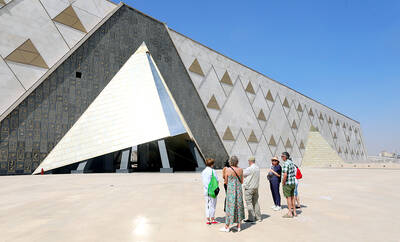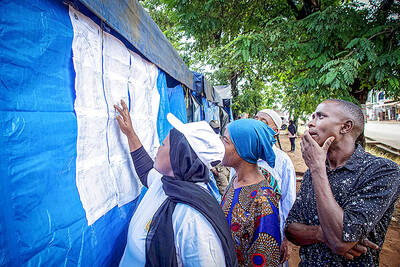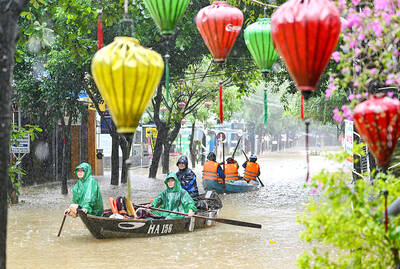A new Chinese ambassador who has previously worked on the country’s controversial Belt and Road Initiative (BRI) has arrived in New Zealand, prompting speculation Beijing is planning to focus on deepening economic ties with New Zealand as the two countries navigate growing diplomatic challenges.
Wang Xiaolong (王小龍) previously served as director-general of the Chinese Ministry of Foreign Affairs’ Department of International Economic Affairs. In that role, Wang helped oversee the BRI — which seeks to deepen economic ties between China and other countries, and is a key focus of Chinese President Xi Jinping (習近平).
The initiative has prompted some skepticism from world governments, particularly those in the West, about Beijing’s motives, with claims the BRI is largely an influence operation. Last month, the EU announced Global Gateway, a 300 billion euros (US$343.8 billion euros) infrastructure spending project aimed at countering the BRI.
Wang appears to be more of a peacemaker figure than the crop of “wolf warrior” diplomats in other foreign postings. In October, he said that some decoupling between the US and China was inevitable, particularly over technology.
He called for China to recognize not just the challenge posed by the US, but also its own growing strength and “the rise of our influence and power to shape the global narrative.”
Given Wang’s background, discussions about New Zealand involvement in the BRI could grow, said Jason Young, director of the Contemporary China Research Centre at Victoria University, who said that the economic relationship between the two had “held up really well compared to some other countries.”
There was some interest in the BRI under former New Zealand prime minister John Key’s center-right government. In 2017, China and New Zealand signed a “memorandum of agreement” to develop a plan for New Zealand involvement.
However ,that engagement stalled following the 2017 election of a Labour-New Zealand First coalition, which took a more skeptical view of the BRI amid reports that it involved “debt-trap diplomacy,” with some poorer countries unable to repay Chinese loans for BRI projects.
Last year, Wellington indicated a willingness to work with China on “mutually beneficial” BRI projects with an environmental emphasis.
It remains unclear what that would involve.
Young said the New Zealand-China relationship has also come under pressure due to China’s “far more illiberal” tendencies in recent years, including economic coercion of Australia and repressive policies in Hong Kong and Xinjiang.
These challenges prompted New Zealand to criticize China more vocally than previously. It has occasionally signed on to criticisms of China issued by more hawkish Anglosphere countries Australia, the US, Canada and the UK.
The government has expressed concern this could lead to trade repercussions. In an interview with the Guardian last year, New Zealand Minister of Foreign Affairs Nanaia Mahuta warned exporters to prepare for a potential “storm” of anger from China.
New Zealand officials have also become more cautious about the implications of growing Chinese aggression for the Indo-Pacific and New Zealand itself. A recent report by the New Zealand Ministry of Defence warned that the country faces “a substantially more challenging environment” due, in part, to China’s “increasingly strong nationalist narrative.”
Despite these challenges, New Zealand’s relationship with China remains relatively stable, Young said.
“If I were a guessing man, I would suggest [Wang’s] focus will be on maintaining the relationship, in the sense of not having a deterioration like that [which] we saw in Australia,” he said.

With much pomp and circumstance, Cairo is today to inaugurate the long-awaited Grand Egyptian Museum (GEM), widely presented as the crowning jewel on authorities’ efforts to overhaul the country’s vital tourism industry. With a panoramic view of the Giza pyramids plateau, the museum houses thousands of artifacts spanning more than 5,000 years of Egyptian antiquity at a whopping cost of more than US$1 billion. More than two decades in the making, the ultra-modern museum anticipates 5 million visitors annually, with never-before-seen relics on display. In the run-up to the grand opening, Egyptian media and official statements have hailed the “historic moment,” describing the

‘CHILD PORNOGRAPHY’: The doll on Shein’s Web site measure about 80cm in height, and it was holding a teddy bear in a photo published by a daily newspaper France’s anti-fraud unit on Saturday said it had reported Asian e-commerce giant Shein (希音) for selling what it described as “sex dolls with a childlike appearance.” The French Directorate General for Competition, Consumer Affairs and Fraud Control (DGCCRF) said in a statement that the “description and categorization” of the items on Shein’s Web site “make it difficult to doubt the child pornography nature of the content.” Shortly after the statement, Shein announced that the dolls in question had been withdrawn from its platform and that it had launched an internal inquiry. On its Web site, Le Parisien daily published a

UNCERTAIN TOLLS: Images on social media showed small protests that escalated, with reports of police shooting live rounds as polling stations were targeted Tanzania yesterday was on lockdown with a communications blackout, a day after elections turned into violent chaos with unconfirmed reports of many dead. Tanzanian President Samia Suluhu Hassan had sought to solidify her position and silence criticism within her party in the virtually uncontested polls, with the main challengers either jailed or disqualified. In the run-up, rights groups condemned a “wave of terror” in the east African nation, which has seen a string of high-profile abductions that ramped up in the final days. A heavy security presence on Wednesday failed to deter hundreds protesting in economic hub Dar es Salaam and elsewhere, some

Flooding in Vietnam has killed at least 10 people this week as the water level of a major river near tourist landmarks reached a 60-year high, authorities said yesterday. Vietnam’s coastal provinces, home to UNESCO world heritage site Hoi An ancient town, have been pummeled by heavy rain since the weekend, with a record of up to 1.7m falling over 24 hours. At least 10 people have been killed, while eight others are missing, the Vietnamese Ministry of Natural Resources and Environment said. More than 128,000 houses in five central provinces have been inundated, with water 3m deep in some areas. People waded through